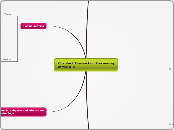Chapter2 Transaction Processing in the AIS
Differentiate Accounting and Bookkeeping
Accounting
The process of
Identifying
Measuring
Communicating
Economic information to permit informed judgments and decisions
By users of the information.
Bookeeping
The elements of accounting associated with
Identifying
Measuring
It's part of accounting; not it's totality.
The accounting cycle
Steps completed each period to :
Identify recordable transactions;
Measure related dollar amounts;
Record transactions in the AIS;
Prepare general purpose financial statements.
Important steps
Throughout the fiscal year
Obtain transaction information from source documents
Analyze transactions
Record transactions in the journal
Post to the ledger
Prepare a trial balance
End of the fiscal year
Record and post adjusting entries
Prepare adjusted trial balance
Prepare financial statements
Record and post closing entries
Prepare post-closing trial balance
Adjusting entries
Purpose--To account for timing differences between cash flow and accrual basis revenue&expense
Types
Accruals--service first,cash second
Revenue
Debit Asset
Credit Revenue
Expense
Debit Expense
Credit Liability
Deferrals--cash first, service second
Revenue
Debit Liability
Credit Revenue
Prepaid Expense
Debit Expense
Credit Asset
Estimates
Depreciation
Debit Expense
Credit Contra asset
Uncolletible accounts
Debit Expense
Credit Contra asset
Financial Statements
Income statement--financial activity on the accrual basis for a specified period of time
Balance sheet--Financial position at a specific point in time
Statement of cash flows
Operating
Investing
Financing
Statement if changes in equity--same period of time as income statement
Closing entries
Prepare the AIS for a new fiscal year
Balances in temporary accounts transferred to Retained Earnings
Revenues
Expenses
Dividends
Transaction types
Internal transactions
Common source documents
Sequential numbering
Physical security
Transaction limits
Other internsl controls
Proper authorizations
Audits
Information technology controls
External treansactions
Coding systems
Types
Sequential coding--simply numbers items in sequence
Numbers in order
Often foe source documents
Block coding--quite common
Codes assigned in blocks
Often for chart of accounts
Hierarchical codes--more sophisticated
Specializws form of block coding
Used for complex chart of accounts
Mnemonic codes--by their nature
Memory aid
Used for inventory items
Commonly applied to
Source documents
Inventory items
Chart of accounts
Human Judgment and information technology
Human Judgment
Used to
Designing source documents
Recognizing recordable transactions
Estimating ampunts and interpreting accounting rules
Essential in the accounting cycle
Information Technology
Useful and common
Not essential in the accounting cycle
used to
Post transactions
Close nominal accounts
General financial statements and other reports
